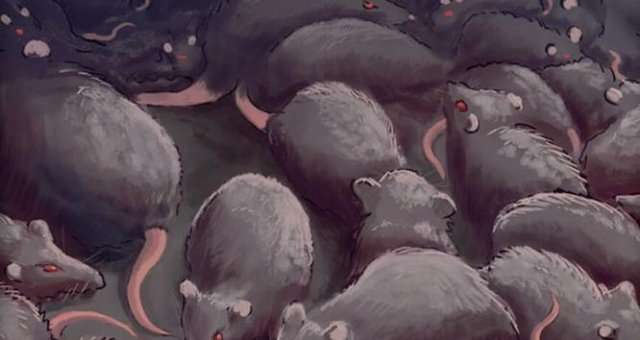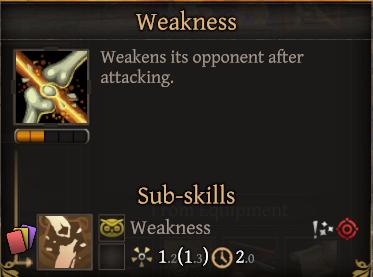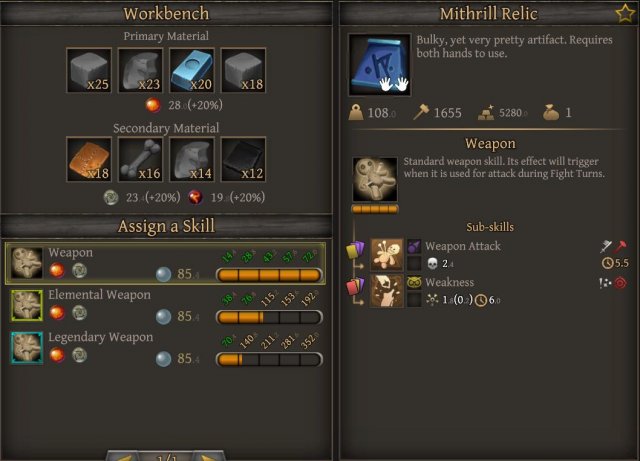
This is a relatively universal strategy for Concept Challenges (the ones where you don’t sustain injuries) taking full advantage of debuffs. It’s very easy to use and the same build can be used for Physical, Mental, and Spiritual Concept Challenges.
Other Thea 2 Guides:
- Introduction to Crafting.
- Beginners Weapons Guide.
- Ringbearer Blues (Other Ring).
- Planning Your Game.
- Healing Guide.
Introduction
This guide details a strategy that is very useful for Concept Challenges, taking advantage of Debuffs (Hunter’s Mark and Weakness).
The following mechanics contribute to this being a simple, yet effective strategy:
- Debuffs persist through Combat Rounds, meaning you can eventually get enemies to hit you for zero damage.
- Characters don’t sustain wounds after Concept Challenges, meaning any and all villagers can be used as meat shields while you spam Debuffs.
- These skills can be used equally well in Physical, Mental, and Spiritual challenges.
The video below shows the strategy in action:
The Skills
Hunter’s Mark
Weakens one enemy and increases its delay. Scales with Perception stat.

Weakness
Weakens up to two enemies (with a lower multiplier per hit) and increases their delay. Scales with Wisdom stat.

Weakness Relic (for Non-Concept Challenges)
You can get the Weakness skill on a 2H Relic by crafting it with Fire or Sunlight as the majority essence, but since it’s a weapon skill, it cannot be used in Concept Challenges. This strategy does not work as well for Non-Concept Challenges because you can’t simply throw all your villagers out as meat shields. If you have summons that are strong enough to tank all incoming damage, then there is almost never a reason to use Debuffs over straight-up dealing damage to your enemies. One notable exception is against big enemies with strong splash damage, in which case your back row is not safe – during these fights, combo-ing Debuffs with strong summons is often the safest way to go.
The Strategy
The core strategy is very simple: Throw up 1-2 meat shields while you use the majority of your Action Points to spam Debuffs.
Here are some additional key considerations for the strategy:
- The more characters that can use Debuffs, the better. This will allow you to use more Debuffs with the same number of Action Points. But you still have to compare the intensity of the debuff (i.e. using a 3.0 Hunter’s Mark with 2 Action Points is still better than two 1.0 Hunter’s Marks with 1 Action Point each).
- The more villagers you have available, the easier these fights become (even way past the soft cap of 7 cards drawn). Take children for example – even if they can’t do anything else, they can still act as meat shields.
- Characters with Innate summon skills are very useful, since equipment cannot provide summon skills for Concept Challenges. This will make it easier to tank.
- Equipment with passive stat boots (especially Shielding) are extremely useful because those DO contribute to Concept Challenges. Shielding will give you much more time to stall while you Debuff, and Perception / Wisdom bonuses respectively will allow you to Debuff faster.
- Always wait until your last Turn to place your meat shields and use your Debuffs. Your meat shields have no reason to go out early because they are only meant for tanking – and sometimes you can place them efficiently to take an extra hit by carefully calculating enemy damage and delay. Generally, you should always Debuff enemies that have clones out, in order to maximize damage reduction. But you should also know that enemies with ranged attacks in Concept Challenges typically have lower base stats and higher damage multipliers, meaning Debuffs will have a stronger effect on them.
- This is minor, but due to decimals and rounding, sometimes enemies showing 0 poison damage will actually do 1 damage.






Be the first to comment